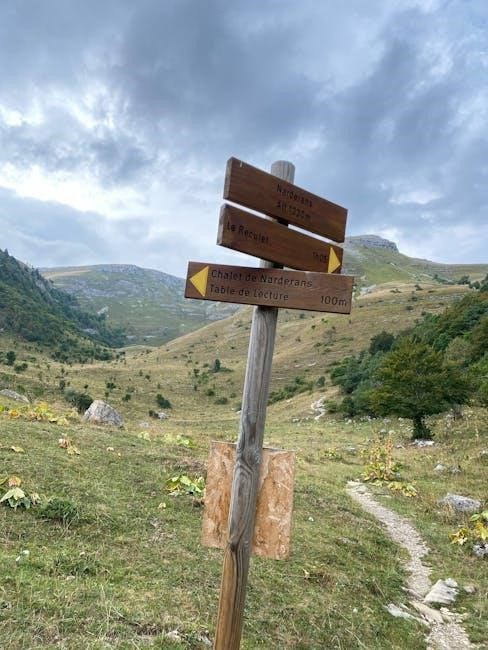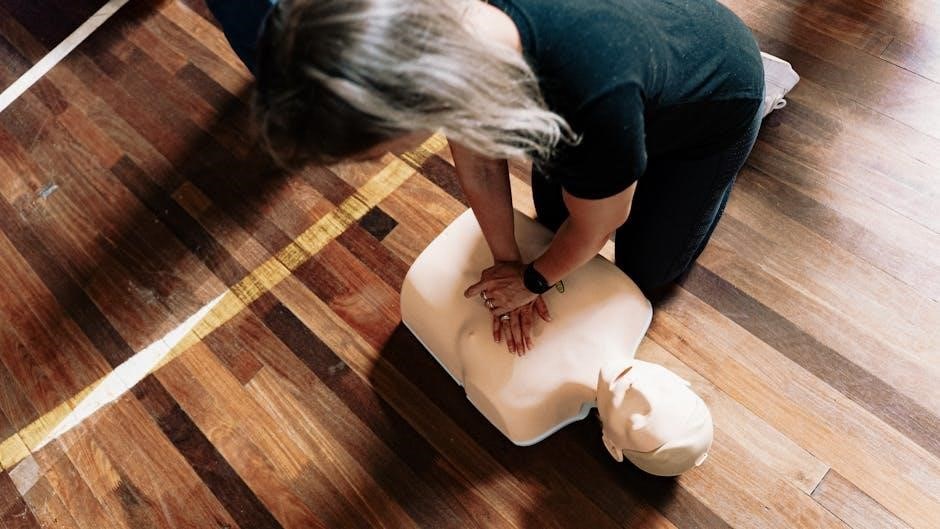The AMGA Guide Certification is a prestigious credential for mountain guides, ensuring high standards of safety, expertise, and professionalism in mountaineering. It validates a guide’s ability to lead safe and successful climbing expeditions across various terrains.
1.1 What is AMGA?
The American Mountain Guides Association (AMGA) is a nonprofit organization dedicated to setting the standard for mountain guiding in the United States. Established to promote safety, professionalism, and excellence in the guiding industry, AMGA provides certification programs for guides specializing in rock, alpine, and ski mountaineering disciplines. It is recognized as the premier organization for mountain guide certification in the U.S., aligning its standards with those of the International Federation of Mountain Guides Associations (IFMGA). AMGA’s mission is to inspire and support a culture of excellence in mountain guiding through education, certification, and advocacy. By fostering a community of skilled and ethical guides, AMGA ensures that climbers and adventurers receive the highest level of expertise and safety in the mountains.
1.2 Importance of Guide Certification
Guide certification through the AMGA is crucial for ensuring high standards of safety, expertise, and professionalism in mountaineering. It validates a guide’s knowledge, skills, and experience, reducing risks for clients and enhancing overall expedition success. Certification demonstrates a guide’s commitment to ongoing education and adherence to industry best practices, fostering trust and confidence among clients. It also sets a benchmark for the guiding industry, promoting consistency and excellence across all disciplines. By requiring guides to meet rigorous standards, certification helps protect both clients and the environment, ensuring responsible and sustainable guiding practices. Ultimately, AMGA certification serves as a badge of credibility, distinguishing qualified professionals in the field and contributing to the growth and reputation of the guiding community.

Overview of the AMGA Guide Certification Program
The AMGA Guide Certification Program offers a comprehensive framework for developing and validating the skills of aspiring mountain guides through rigorous training, exams, and mentorship opportunities.
2.1 History of the AMGA Certification

The AMGA certification program was established in the late 1990s to standardize guide competencies in the U.S., mirroring international standards. It evolved from the need for consistent, professional training and evaluation in mountaineering. Initially inspired by European guiding traditions, the program aimed to ensure guides could safely lead climbers in diverse environments. Over time, the certification has been refined to incorporate modern techniques, safety protocols, and environmental considerations. Key milestones include the first certifications awarded in the early 2000s and the expansion of disciplines to include rock, alpine, and ski mountaineering. Today, it remains a cornerstone of professional development for guides, continually updating to meet the demands of the industry.
2.2 Structure of the Certification Process
The AMGA certification process is structured into distinct phases, ensuring comprehensive evaluation of a guide’s skills. It begins with prerequisites, such as experience and basic certifications, followed by intensive training courses. These courses cover technical skills, risk management, and leadership. After training, candidates must pass a rigorous examination, which includes both written and practical assessments. The process culminates in a final evaluation where candidates demonstrate their ability to lead climbs and make sound decisions in real-world scenarios. The structure is designed to progressively build and test a guide’s expertise, ensuring they meet the highest industry standards. This multi-step approach ensures only the most qualified individuals achieve certification.

Climbing Disciplines in AMGA Certification
The AMGA certification encompasses three primary climbing disciplines: Rock, Alpine, and Ski Mountaineering. Each requires distinct skills and expertise, ensuring guides are versatile, knowledgeable, and highly competent professionals.
3.1 Rock Guide Certification
The Rock Guide Certification is a specialized credential within the AMGA program, focusing on guiding rock climbing in single-pitch and multi-pitch environments. It emphasizes technical proficiency, risk management, and the ability to lead climbers safely on diverse rock formations. Candidates must demonstrate expertise in route selection, anchor placement, and rope systems. The certification process includes rigorous training, practical examinations, and a thorough assessment of decision-making skills. Rock guides are prepared to handle various climbing scenarios, from sport climbs to traditional routes, ensuring a high level of competence and safety. This certification is essential for guides working in rock climbing environments, validating their ability to lead and instruct effectively in dynamic outdoor settings.
3.2 Alpine Guide Certification
The Alpine Guide Certification is a advanced credential within the AMGA program, designed for guides working in alpine environments. It focuses on the skills needed to navigate glaciated terrain, high-altitude peaks, and complex mountain routes. Candidates must demonstrate proficiency in ice climbing, crevasse rescue techniques, and route finding in challenging conditions; The certification emphasizes safety, decision-making, and the ability to lead climbers in dynamic alpine settings. Training and assessment cover both technical skills and the ability to manage risks in unpredictable weather and terrain. This certification is essential for guides aspiring to lead expeditions in alpine environments, ensuring they possess the expertise to handle the unique challenges of high-mountain guiding. It represents a high level of competence and readiness for alpine adventures.
3.3 Ski Mountaineering Guide Certification
The Ski Mountaineering Guide Certification is a specialized credential for guides leading ski mountaineering expeditions in complex, snowy terrain. This certification focuses on the unique skills required to navigate both uphill and downhill skiing in high-alpine environments. It emphasizes proficiency in route finding, avalanche safety, and managing variable snow conditions. Candidates must also demonstrate advanced climbing skills, as ski mountaineering often involves accessing terrain via technical ascents. The certification process includes rigorous assessments of a guide’s ability to lead groups safely and efficiently in challenging winter conditions. This credential is essential for professionals aiming to guide ski mountaineering trips, ensuring they possess the expertise to handle the distinct challenges of this discipline. It underscores a guide’s ability to lead safely and effectively in alpine ski environments.

Becoming an AMGA Certified Guide
Becoming an AMGA Certified Guide involves a comprehensive process of training, examination, and accumulated experience, ensuring guides possess the highest level of skill and professionalism required for safe and effective mountain guiding.
4.1 Prerequisites for Certification
To pursue AMGA certification, candidates must meet specific prerequisites, including a minimum age of 18, current medical certification, and demonstrated climbing experience. They must also complete a recognized first aid course and hold membership in the AMGA. Additionally, candidates are required to possess a strong foundation in both technical climbing skills and leadership abilities, as these are critical for guiding safely and effectively. These prerequisites ensure that only qualified individuals proceed through the certification process, maintaining the high standards of the AMGA. By fulfilling these requirements, candidates demonstrate their commitment to professionalism and safety in the field of mountain guiding.
4.2 Training and Examination Process
The AMGA certification process involves rigorous training and evaluation. Candidates participate in multi-day courses led by certified instructors, focusing on advanced climbing techniques, risk management, and group leadership. The training emphasizes practical application, with hands-on exercises in real-world scenarios. Following the training, candidates must pass a comprehensive examination that assesses both theoretical knowledge and practical skills. The exam includes demonstrations of technical proficiency, decision-making under pressure, and the ability to communicate effectively with clients. Successful completion of both the training and examination is required to achieve certification, ensuring that guides meet the highest industry standards. This thorough process guarantees that AMGA-certified guides are fully prepared to lead safe and successful climbing expeditions.
4.3 Role of Mentorship in Certification
Mentorship plays a crucial role in the AMGA certification process, providing candidates with personalized guidance and expertise. Experienced certified guides serve as mentors, offering valuable insights and hands-on experience. Through one-on-one interactions, mentors help candidates refine their skills, address weaknesses, and gain confidence. Mentorship also fosters a deeper understanding of industry standards and best practices, ensuring candidates are well-prepared for the certification exams. Additionally, mentors provide feedback and support, helping candidates navigate the challenges of the certification journey. This collaborative approach not only enhances the quality of training but also upholds the high standards of the AMGA certification program. Mentorship is integral to producing competent and professional guides who are ready to lead safe and successful climbing expeditions.

Benefits of AMGA Certification
AMGA certification enhances credibility, demonstrates expertise, and provides a competitive edge in the guiding industry. It ensures guides meet the highest standards, fostering trust and confidence among clients.
5.1 Enhanced Professional Credibility
AMGA certification is a badge of honor, widely recognized as the gold standard in the guiding industry. It signals to clients and peers that a guide has achieved the highest level of competence, safety, and professionalism. By earning this credential, guides demonstrate their commitment to upholding rigorous standards, which fosters trust and confidence among clients. The certification also distinguishes guides in a competitive market, making them more attractive to potential employers and adventurers seeking reliable expertise. It reflects a guide’s mastery of both technical skills and decision-making abilities, ensuring they can handle diverse and challenging conditions. Ultimately, AMGA certification elevates a guide’s reputation, opening doors to new opportunities and solidifying their standing as a respected professional in mountaineering and adventure guiding.
5.2 Improved Climbing and Guiding Skills
The AMGA certification process is designed to refine and enhance both climbing and guiding abilities. Through rigorous training and assessments, guides develop advanced technical skills, such as rope work, anchor placement, and route selection. The program emphasizes decision-making, risk management, and adaptability, ensuring guides can navigate complex terrain and unpredictable conditions. Additionally, the certification fosters interpersonal skills, such as effective communication and client interaction, which are crucial for leading successful and safe expeditions. By mastering these competencies, guides not only elevate their personal climbing proficiency but also become more effective leaders and educators. The result is a well-rounded professional capable of delivering exceptional experiences while prioritizing safety and client satisfaction.
5.3 Networking Opportunities
AMGA certification provides access to a robust network of professional guides and industry experts. By joining the AMGA community, guides connect with like-minded professionals, sharing knowledge and best practices. This network opens doors to collaborative opportunities, such as joint expeditions or shared resources. Additionally, AMGA events and workshops offer platforms for guides to meet potential employers or partners, enhancing career prospects. The certification also grants access to exclusive forums and groups, fostering ongoing professional development. These connections not only expand personal and professional horizons but also contribute to the growth of the guiding community as a whole. Overall, the networking opportunities through AMGA certification are invaluable for building lasting relationships and advancing one’s career in the field.
Maintaining AMGA Certification
Maintaining AMGA certification requires ongoing professional development through continuing education and periodic re-certification. This ensures guides stay updated on industry standards, safety protocols, and best practices.
6.1 Continuing Education Requirements
AMGA certification requires guides to complete continuing education to maintain their credentials. Courses focus on advanced skills, safety protocols, and industry updates. Guides must earn a set number of credits through approved programs, such as avalanche safety training, medical response, and technical skill refreshers. These requirements ensure that certified guides stay current with evolving techniques, equipment, and best practices in mountaineering. Continuing education also promotes lifelong learning and adaptability in a dynamic field. By staying informed and skilled, guides enhance client safety and program quality. The AMGA regularly updates its education standards to reflect industry advancements, ensuring certified guides remain leaders in their profession.
6.2 Re-Certification Process
The AMGA re-certification process ensures guides maintain high standards of competence and professionalism. Guides must renew their certification periodically, typically every few years, by demonstrating continued expertise. The process involves a combination of practical exams, peer reviews, and documentation of ongoing experience. Guides are evaluated on their ability to lead safely, make sound decisions, and adapt to changing conditions. Re-certification also requires completion of continuing education credits and adherence to updated industry protocols. This process helps guides stay current with evolving techniques and safety standards. By renewing their certification, guides reaffirm their commitment to professional development and client safety, maintaining the credibility and trust associated with AMGA certification.

The Future of AMGA Guide Certification

The future of AMGA certification lies in adapting to evolving technologies, environmental challenges, and global climbing trends, ensuring guides remain highly skilled and safety-focused professionals.
7.1 Evolving Industry Standards

The AMGA Guide Certification is continually aligning with advancing industry standards to reflect modern climbing techniques, safety protocols, and environmental considerations. As the climbing industry grows, the certification process adapts to include new technologies, such as improved avalanche forecasting tools and rope systems. Additionally, there is a stronger emphasis on sustainability and Leave No Trace practices to minimize the environmental impact of guiding operations. AMGA also collaborates with international guiding associations to ensure standards remain consistent with global best practices. These evolutions ensure that certified guides are equipped to handle the challenges of a rapidly changing outdoor environment while maintaining the highest level of professionalism and safety.
7.2 Technological Advancements in Guiding

Technological advancements are revolutionizing the field of mountain guiding, with AMGA Certification incorporating these innovations to enhance safety and efficiency. Guides now utilize GPS and real-time weather monitoring systems to make informed decisions in the field. Lightweight and durable equipment, such as improved crampons and ropes, has also transformed climbing practices. Communication devices like satellite phones and two-way radios enable better coordination between guides and teams. Additionally, virtual reality and simulation tools are being integrated into training programs to provide immersive learning experiences. These technologies not only improve the effectiveness of guiding but also align with AMGA’s commitment to staying at the forefront of industry developments, ensuring guides are well-prepared for modern challenges.
